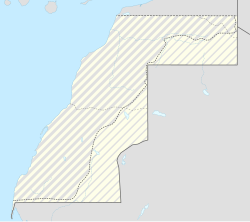Smara
Smara
السمارة Esmara | |
|---|---|
 | |
| Coordinates: 26°44′22″N 11°40′13″W / 26.73944°N 11.67028°W | |
| Country | Western Sahara |
| Claimed by | |
| Controlled by | Morocco |
| Founded | 1869 |
| Population (2014)[1] | |
| • Total | 57,035 |
Smara (Template:Lang-ar as-Samāra, also romanized Semara; Template:Lang-es) is a city in the Moroccan-controlled part of Western Sahara, with a population of 57,035 recorded in the 2014 Moroccan census.[1] It is served by Smara Airport and Smara bus station.
History
The largest city in its province, Smara was founded in the Saguia el-Hamra as an oasis for travellers in 1869. In the center of the city the remains of a stone fortress can be found, the Zawiy Maalainin, which enclosed a mosque. The Maalainin lived there from 1830 until 1912. It was made a capital and religious center in 1902 by shaykh Ma al-'Aynayn, in what was then Spanish Sahara. The location of the city was intended to ensure its becoming a caravan trade hub in the sparsely populated Sahara desert. The enlargement of Smara was carried out by local Sahrawis as well as craftsmen sent by the sultan Hassan I. In 1902, shaykh Ma al-'Aynayn moved to Smara and declared it his holy capital. Among other things, he created an important Islamic library, and the town became a center of religious learning.
In 1904 the shaykh declared himself an imam and called for holy war (jihad) against French colonialism, which was increasingly pressing into the Sahara at this time. During the campaign against Ma al-'Aynayn, Smara was sacked almost completely in 1913 by the French Army, and its library destroyed.[2] The town was then handed over to the Spanish. In 1934 the town was once again destroyed after Sahrawi rebellions against the Spanish occupation.
The Vieuchange brothers
Reaching Ma el Ainain's mysterious Smara was the goal of the brothers Vieuchange, early 20th-century French writers and romantics. Michel Vieuchange's painful journey through the rebel-held Sahrawi lands in 1930 disguised as a Berber tribeswoman, eventually reaching Smara on 1 November 1930, and the dysentery that led to his death on the return, is documented in his journals.[3] Comprising seven notebooks and more than 200 photographs, the account was published posthumously in 1932 as Smara: The Forbidden City (1932) by his brother Jean and became a bestseller.
After 1975
In 1975, Morocco took control of Saguia Elhamra as Spain withdrew, according to the Madrid Accords. The Moroccan army took the city from the Polisario Front in 1976. Near Tindouf, Algeria, there still exists a Sahrawi refugee camp named after Smara. It is one of the four camps of the Sahrawi Arab Democratic Republic administration in Algeria.[4]
The town is controlled by the Moroccan authorities, as part of what the government terms its Southern Provinces, and enclosed by a section of the Moroccan Wall.
Transport
CTM, Supratours and Satas companies have daily travels from Smara to Agadir. Supratours have daily travel from Smara to Laayoune.
Notes and sources
- Notes
- ^ a b "POPULATION LÉGALE DES RÉGIONS, PROVINCES, PRÉFECTURES, MUNICIPALITÉS, ARRONDISSEMENTS ET COMMUNES DU ROYAUME D'APRÈS LES RÉSULTATS DU RGPH 2014" (in Arabic and French). High Commission for Planning, Morocco. 8 April 2015. Retrieved 29 September 2017.
- ^ "After a defeat of the French at Lebeyratt, Colonel Mouret mounts an attack against Smara. Leaving from Teyarett (in the north-west of Atar) on the 9th of February, he arrives in the Zemmour on the first of March to sack the holy city (Smara). He finds her empty of all people." (Le Rumeur (Guy): Le Grand Méhariste, Paris, Berger Levrault)
- ^ Vieuchange (1988), pp. 2–3.
- ^ According to the American Refugee Committee (ARC), approximately 39,000 Sahrawi refugees live in Asward camp, 30 kilometres (19 mi) from Tindouf; some 38,000 live in Dakhla camp, which is the furthest at 180 km (110 mi) from Tindouf; an estimated 39,000 refugees live in Laayoune camp, about 10 km (6.2 mi) from Tindouf; and more than 39,000 Sahrawi refugees live in Smara camp, which is 50 km (31 mi) from Tindouf. The number of refugees in the camps has, according to ARC, quadrupled since 1979.
- Sources
- Vieuchange, Michel (1988) [1932]. Smara: The Forbidden City. Fletcher Allen, Edgar (translation); Vieuchange, Jean (editor; introduction, notes, postscript); Claudel, Paul (preface). (Reprinted ed.). New York: Ecco. ISBN 978-0-88001-146-4.
{{cite book}}: Invalid|ref=harv(help)
External links
- Entry in Lexicorient
- ad for "Smara: The Forbidden City" by Jean and Michel Vieuchange (ISBN 0-88001-146-7)
- Satellite view in Google Maps


